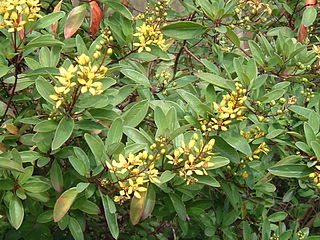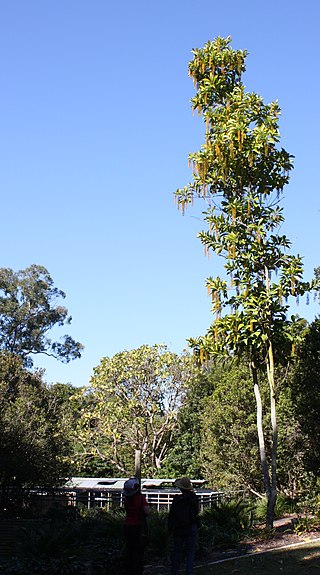
Malpighiaceae is a family of flowering plants in the order Malpighiales. It comprises about 73 genera and 1315 species, all of which are native to the tropics and subtropics. About 80% of the genera and 90% of the species occur in the New World and the rest in the Old World.

Mezia is a genus in the Malpighiaceae, a family of about 75 genera of flowering plants in the order Malpighiales. Mezia comprises 10 species of woody vines and lianas native to South America, with one species extending into Panama.
Carolus is a genus in the Malpighiaceae, a family of about 75 genera of flowering plants in the order Malpighiales. Carolus comprises six species of woody vines native to Mexico, Central America, the Lesser Antilles, and South America.
Adelphia is a genus in the Malpighiaceae, a family of about 75 genera of flowering plants in the order Malpighiales. Adelphia comprises four species of woody vines native to the West Indies, Mesoamerica, and western South America.
Alicia is a genus in the Malpighiaceae, a family of about 75 genera of flowering plants in the order Malpighiales. Alicia comprises 2 species of woody vines widespread in South America.

Franz Josef Niedenzu was a German botanist born in Köppernig. He is remembered for his work with the botanical family Malpighiaceae.

Amorimia is a genus in the Malpighiaceae, a family of about 75 genera of flowering plants in the order Malpighiales. Amorimia comprises ten species of woody vines native to South America.
Barnebya is a genus in the Malpighiaceae, a family of about 75 genera of flowering plants in the order Malpighiales. Barnebya comprises 2 species of trees and woody vines native to eastern Brazil. The genus is named in honor of the American botanist Rupert Charles Barneby (1911–2006).

Galphimia is a genus in the Malpighiaceae, a family of about 75 genera of flowering plants in the order Malpighiales; the name is an anagram of Malpighia.Galphimia comprises 26 species of large herbs, shrubs, and treelets. Twenty-two species occur in Mexico, one extending into Texas and one ranging to Nicaragua; four species occur in South America, south of the Amazon Basin. Galphimia gracilis is widely cultivated in warm regions throughout the world. Eight species are distinctive in that the petals become stiff and papery, and persist past the stage of fruit maturation.
Spachea is a genus in the Malpighiaceae, a family of about 75 genera of flowering plants in the order Malpighiales. Spachea comprises 6 species of shrubs and trees growing in wet forests. One species occurs in Cuba, 2 species in southern Central America with one of those also in adjacent Colombia, and 3 species in northern South America. Spachea correae, native to Costa Rica and Panama, is listed in the IUCN Red List of Threatened Species.

Lophanthera is a genus in the Malpighiaceae, a family of about 75 genera of flowering plants in the order Malpighiales. Lophanthera comprises 5 species of shrubs and trees, all but one native to the Amazonian South America; the exception is from Costa Rica. Lophanthera lactescens has become popular in recent decades as a cultivated ornamental in many warm regions of the Old and New World. It is propagated by cuttings and seeds.
Mcvaughia is a genus in the Malpighiaceae, a family of about 75 genera of flowering plants in the order Malpighiales. Mcvaughia contains only one species, Mcvaughia bahiana, a shrub occurring in open shrubby vegetation (caatinga) on sandy soils of lowland Bahia, Brazil. It is related to Burdachia and Glandonia.
Excentradenia is a genus of plants in the family Malpighiaceae. Excentradenia comprises four species of woody vines native to the forests of northern South America.
Psychopterys is a genus in the Malpighiaceae, a family of about 75 genera of flowering plants in the order Malpighiales. Psychopterys comprises 8 species of woody vines, occasionally described as shrubs or small trees, which occur in matorral, tropical deciduous forest, and wet forest in southern Mexico, Guatemala, and Belize. This genus is very distinctive because of its nearly radial white corollas and eglandular sepals, which are highly unusual characteristics in the Malpighiaceae of the New World.

Callaeum is a genus in the Malpighiaceae, a family of about 75 genera of flowering plants in the order Malpighiales. Callaeum comprises 11 species of woody vines and shrubs occurring from western Texas to Mexico, Central America, and South America. Two species, C. macropterum and C. septentrionale are cultivated as ornamentals in Arizona and California.
Christianella is a genus in the Malpighiaceae, a family of about 75 genera of flowering plants in the order Malpighiales. Christianella comprises 5 species of woody vines and shrubby habit occurring in forests, roadside thickets, and shrubby savannas in southeastern Mexico, Central America, and South America.
Bronwenia is a genus in the Malpighiaceae, a family of about 75 genera of flowering plants in the order Malpighiales. Bronwenia comprises 10 species of shrubs and woody vines native to Mexico, Central America, and South America.
Cottsia is a genus in the Malpighiaceae, a family of about 75 genera of flowering plants in the order Malpighiales. Cottsia comprises 3 species of slender twining vines native to northern Mexico and extending into Texas, New Mexico, and Arizona. The species of Cottsia were formerly included in Janusia, a genus of South America.

Madagasikaria is a genus in the Malpighiaceae, a family of about 75 genera of flowering plants in the order Malpighiales. Madagasikaria contains only one species of woody vine native to deciduous seasonally dry forest of Madagascar.
Dicella is a genus in the Malpighiaceae, a family of about 75 genera of flowering plants in the order Malpighiales. Dicella includes seven species, assigned to two sections. Section Dicella comprises D. bracteosa and D. nucifera, found in southeastern Brazil and adjacent Paraguay and Argentina. Section Macropterys includes D. aciculifera, known only from Costa Rica, and D. conwayi, D. julianii, D. macroptera, and D. oliveirae, all of South America from Colombia south to about 19°S







